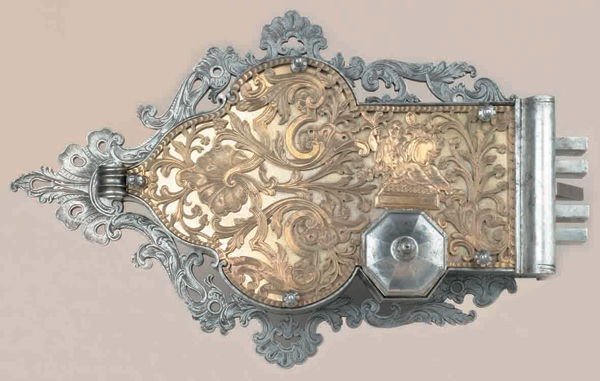One of the great treasures of the musée Le Secq des Tournelles, whose 14 000 pieces document the art of wrought iron work, is its collection of locks: locks of all ages and times, since the XVth century, from all origins - France, Italy, Germany, Austria, Flanders - and of all sorts, from the gate lock to the purse lock. The exhibition «The faithful opening or the art of the locksmith» confronts all the locks from the museum to exceptional pieces from various French and foreign collections. It gives life to a discipline that Dante referred to in his Divine Comedy as one of the liberal arts.
A stroll through time
The visit is organized chronologically, from the XVth to the XIXth century, and enhanced by a beautiful series of master's locks. In France, the corporation sponsored by saint Eloi defined very strict conditions to access the profession. It was mandatory, since the XIIIth and XIVth centuries to create a masterpiece. A lock from 1524, in the shape of a portico of the Renaissance, is possibly the first to be explicitly dated. The complexity of the mechanisms the master locksmith had to put into place as well as the fact he dominated the art of fire gave the artisan a particular aura. His know-how was prestigious: wrought iron work was considered as the fourth liberal art, next to painting, sculpture and music. In his free time, Louis XVI submitted himself to learn it. When the corporations disappeared at the end of the Ancien Régime, the master's piece prevailed until the XIXth century, maintained by the spirit of the guilds, even though the skill seemed less mastered than in the Middle Ages or at the time of the Renaissance.
Masterpieces from abroad
As of 1900, Henry Le Secq, the son of the founder of the collection, presented one thousand objects at the Universal Exposition in Paris, in the section called «Retrospective wrought Iron work». That simply gives us an idea of the wealth of the museum, set up since 1921 in the church of Saint-Laurent. As to better situate the locks, they have been put opposite 45 pieces borrowed from other collections. One will discover among others the chest lock with the twelve apostles from the Cluny museum, the lock from the castle of Ambras (Austria), decorated with etchings associating the religious theme of the Calvary to the mythological theme of the judgment of Paris, the lock from the Beddigton House bearing the arms of the Tudor family (towards 1539-1552), the chest lock with four caryatids from the museum of Angers (XVIIth century) or the Medicis lock designed by Bicford (towards 1660, London). In Germany it is still mandatory to manufacture a master's piece before opening a workshop and training apprentices, thus perpetrating a centuries-old tradition. In 1990 for example, the chamber of trades of Augsbourg asked its candidates to manufacture a combination Chubb lock with six catches while the chamber of trades in Bayreuth demanded in 1993 an iron casket with a combination lock.
A complete scientific study
The exhibition rests on a complete scientific work in which the study of locks is confronted with the ancient treaties by Mathurin Jousse or Duhamel du Monceau. The restoration work carried out with the specialist in locks, Alain de Saint-Exupéry, has contributed immensely. Indeed the two aspects of locks are studied, their façade and their mechanism, in order to be correctly dated. The exhibition is an original manifestation offering the public a real initiation to this very elaborate discipline that requires long and constant efforts to learn how to master fire, to master different irons, as well as associated metals (silver, brass, copper) and an impressive range of tools, in all some 160 pieces. The musée des Arts et Métiers (institute for industrial art and design) has lent a miniature locksmith workshop for this event. Presented at the Universal Exposition of 1900, it summarizes in a very pleasant manner the complexity of this art.
PUBLICATION:
Catalogue of the exhibition, unique reference work in France, 272 p. illustrated in colors, 38 €
Illustration: Chest key England, XVIIIth century Rouen, musée Le Secq des Tournelles
To see more illustrations, click on VERSION FRANCAISE at the top of this page
| 








